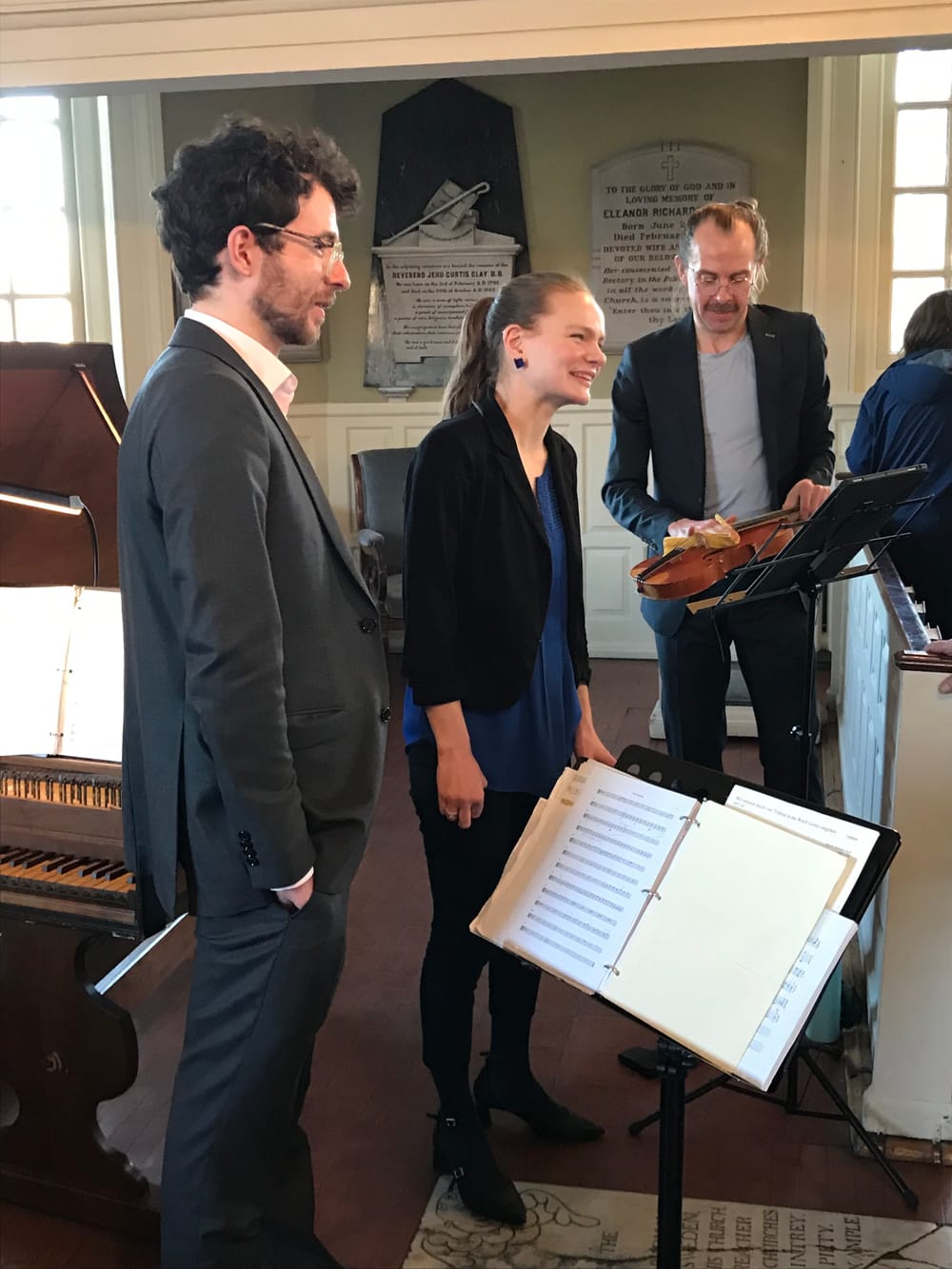Stay in the Loop
BSR publishes on a weekly schedule, with an email newsletter every Wednesday and Thursday morning. There’s no paywall, and subscribing is always free.
Bach, Buxtehude, and other baroque favorites
Filament presents The Muse’s Prism

Many young classical musicians decide they want to form a new group. But not many are as clear about their goal or as much in the ascendant as Evan Few (violin), Elena Kauffman (viola da gamba), and harpsichordist John Walthausen. Known as Filament, this early music ensemble was formed in 2019, and they celebrated their fifth anniversary with a concert of crystalline and perfectly balanced music.
Somewhat cryptically titled The Muse’s Prism, it was played at Philadelphia’s Gloria Dei (Old Swedes’s) Church, a space that warmly embraces this music both acoustically and historically. For this concert in a favorite venue, the baroque trio picked nine of their favorite works, several in their own transcriptions, by nine 17th- and 18th-century composers. Some names were familiar, like Johann Sebastian Bach (1685-1750) and Dieterich Buxtehude (1637-1707).
But some were not. New discoveries were composers like Antonio Bertali (1605-1669), Élisabeth Claude Jacquet de la Guerre (1665-1720), and the ubiquitous Anonymous, whose untitled six-movement dance suite opened the concert. This first work and two others on the program—by Bertali and Samuel Capricornus (1628-1665)—are from the Düben Collection, manuscripts of 17th-century music named after their original collector Gustaf Düben. This Swedish collection, which Filament regularly explores, includes the only surviving copies of many works by Buxtehude.
“Bring others along”
Bertali’s Sonata a due, the second work on the program, opens with an elegiac soaring line for violin embellished by the gamba, resulting in conversational flourishes in an almost call-and-response format. The two instruments (undergirded by harpsichord continuo) have surprisingly equal prominence, echoing one another’s lines in highly expressive passages that allow the gamba to shine, something often reserved for the violin in this period of repertoire.
Walthausen introduced the third work on the program, Cantio Sacro, from a 1624 collection titled Tabulatura Nova by Samuel Scheidt (c.1587-1654), saying that it was originally written for keyboard. But the composer noted that the work could be freely interpreted by any musicians who happened to be available, instructing the keyboard player to “bring others along.” Filament took this as permission to make their own transcription, and they structured the eloquent work so that each of the three was equally featured.
Next were four arrangements (again, Filament’s own) of four chorale preludes from Bach’s Chorales “von verschiedener Art” (BWV 645-650). Throughout, the players arranged Bach’s melodious lines and fugal counterpoint in ways that allowed each instrument to speak individually. One of the strengths of Filament transcriptions is how they are seamlessly tailored to the three players. In their concerts, the group’s linear clarity and intimate ensemble work allow the hearer a clear passage into the overlapping, complex lines of this contrapuntal music as, all the while, the group continues to speak as one.
Another anonymous work on the program was Sonata 27 a due from the Durham (England) Cathedral Manuscript Collection. There is no edition of the sonata, and it’s not in the known repertoire; it exists in the cathedral’s library in a manuscript notebook. The piece—notated for Filament’s exact instrumentation—was a treasure to unearth, filled with beautifully constructed duets, solo lines, and virtuosic writing, and the ensemble hopes to be able to mine Durham’s 5,000 handwritten pages for more unknown works like this sonata.
Beautiful Buxtehude
Among the nine gems, the highlight of The Muse’s Prism was Buxtehude’s Sonata V, Op. No. 1. Filament first read his trio sonatas of Opus 1 in 2019, when they were initially exploring the possibility of becoming an ensemble, and it continues to inspire and invigorate the group. In the spring of 2022, they made their first recording (still yet to be released): the seven works in this 1694 set. Here, they gave an impeccably polished reading of Sonata V, which includes a luminous duet for violin and harpsichord amid the lush harmonies and shifting chromatics for which this composer is so revered.
The concert concluded with Capricornus’s spritely Ciaccona, notable for an almost perpetual motion ostinato in the keyboard line that anchors dancing string sections, a work that delicately faded away, ending an afternoon of remarkable music.
Few, Kauffman, and Walthausen are equally matched in virtuosity, and the ensemble continues to deepen and widen its repertoire. Among the group’s accolades are its selection as one of Early Music America’s 2021 Emerging Artists. This week, Filament takes The Muse’s Prism to New Orleans, and the concert will also be played in Bethesda, Maryland, in April. In May, the group will celebrate the release of the Buxtehude recording. Their stated goal is to “be the bright connective thread—that eponymous filament” that links audiences with the world of their repertoire, and through these vibrant, informed concerts they continue to do so with fervor, delight, and growing maturity.
At top: From left, John Walthausen, Elena Kauffman, and Evan Few at their February 25, 2024, concert at Gloria Dei. (Photo by Gail Obenreder.)
What, When, Where
The Muse’s Prism. Evan Few, violin; Elena Kauffman, viola da gamba; and John Walthausen, Harpsichord. February 25, 2024, at Historic Gloria Dei (Old Swedes’s) Church, 916 S Swanson Street, Philadelphia. filamentbaroque.com.
Accessibility
Patrons must enter the Gloria Dei (Old Swedes’s) Church via shallow steps.
Sign up for our newsletter
All of the week's new articles, all in one place. Sign up for the free weekly BSR newsletters, and don't miss a conversation.

 Gail Obenreder
Gail Obenreder